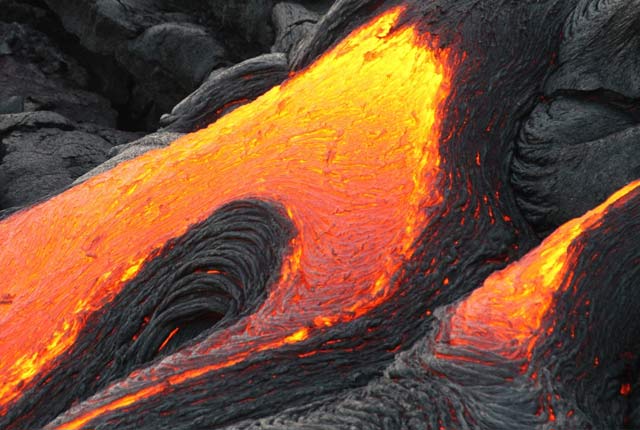Volcanic eruptions are often dramatic events that attract attention, sometimes on a global stage. Out of curiosity and awe, we are often drawn to volcanic landscapes to view the incredible power of nature first hand.
But what about the people that live alongside an active volcano every day? On first thought, it may seem unwise to choose to live with such hazardous neighbours, but all of us live with risk every day: we weigh the risks up against the benefits.
Here are some of the main reasons why people live alongside volcanoes.
Farming
Volcanic environments can be good locations for farming. Volcanic deposits are enriched in elements such as magnesium and potassium. When volcanic rock and ash weathers, these elements are released, producing extremely fertile soils. Thin layers of ash can act as natural fertilisers, producing increased harvests in years following an eruption. In response to frequent eruptions, some farmers have adapted their crops and farming styles to suit different types of ash.
Volcanic deposits (particularly ash) are also quite porous, retaining moisture longer than many non-volcanic soils. As a consequence, land close to a volcano is often good for agriculture.

Crops growing in the fertile soils of the Popocatépetl volcano, Mexico. © Alexander Schimmeck/Unsplash.
Eruptive products and the forces that produce them shape the landscape, sometimes removing land and sometimes adding to it. For example in 1973, in Iceland, the volcano of Eldfell on the island of Heimaey erupted. Heimaey has Iceland’s only harbour in the south of the country and for a few months it appeared that this would be destroyed. However, when the lava did stop flowing it had increased the land area by over 2 km² and actually enhanced the shape of the harbour, making it more of a safe haven for the fishing fleet than it was originally!


Close to home: living and farming with volcanic ash. Eruptions of the volcano Tungurahua in Ecuador, from 1999 until 2016, produced ash fall that affected people living on the slopes of the volcano. Source: Strengthening Resilience in Volcanic Areas project.
Attachment
Volcanic environments often evoke a strong sense of place. Whether is it driven by aesthetics, community, history, culture or religion, volcanic communities often have a very strong bond with ‘their’ volcano and assign strong symbolic meanings to their environment.
More than that, volcanic environments are simply just home for many people. That’s where their family, friends and jobs are.

In May 2018, cracks appears in roads in the Leilani Estates housing subdivision in Hawaii, on the flanks of the Kilauea volcano. Within days a large fissure eruption was underway that destroyed more than 700 homes and created about 875 acres of new land. © US Geological Survey.
Tourism
Volcanoes evoke wonder and attract millions of tourists around the world. This supports local economies and provides jobs.

The volcano Vesuvius (seen in the background) destroyed the ancient Roman cities of Pompeii and Herculaneum, near the modern city of Naples, in an eruption in the first century AD. The sites are now major tourist destinations despite the promximity of the volcano, which last erupted in 1944. © Norbert Nagel/Wikimedia Commons under licence CC BY-SA 3.0.
Resources
Volcanic environments can produce rich mineral or metallic ore deposits when rocks are ‘cooked’ in extremely hot water in a process called hydrothermal alteration.
The country of Cyprus, which roughly translated means copper, owes its name to the mining of copper deposits. This copper occurs in parts of the Earth’s crust that has been pushed upwards; long ago, sea water circulated through the volcanic oceanic crust and was heated up to 350°C. This heated water became acidic and corroded the rock through which it was flowing, becoming enriched in elements such as copper. On cooling, minerals such as copper sulphides were deposited.

The Roman supply of copper came almost entirely from Cyprus; it was known as aes Cyprium, ‘metal of Cyprus’. © Thanasis Papazacharias/Pixabay.
Energy
As well as providing mineral resources, many countries with active volcanoes are able to use the heat generated by volcanic activity as geothermal energy (e.g. Iceland and New Zealand). Water in the upper crust of the Earth is heated above a magma chamber or rocks that are still very hot; this is often apparent on the surface due to the presence of hot springs or geysers. To use this water as geothermal energy, the water needs to be pressurised. Pressure builds up when the boiling water is trapped beneath a dense impermeable rock layer, such as a clay, preventing it from expanding. By drilling a deep hole through this layer, the steam rises to the surface and expands, either driving turbines or being directed through heat exchangers.

In Iceland 25 per cent of the country’s total electricity production is from geothermal energy and over 66 per cent of their primary energy use, including the heating of nine out of ten homes. © WikiImages/Pixabay.
Practicality
Some people simply cannot afford to move elsewhere.
Coercion
Sometimes, people are forced by others to live in these environments.
References
British Geological Survey. 2012. Geohazard note: Volcanic hazards. British Geological Survey.
You may also be interested in

Discovering Geology
Discovering Geology introduces a range of geoscience topics to school-age students and learners of all ages.

Earth hazards
The Earth beneath our feet is constantly shifting and moving, and violently with catastrophic and immediate results. Find out more about earth hazards.

How volcanoes form
How the different types of volcano are formed and the relationship with plate tectonics.

Types of volcano
Different types of volcano are formed according to the properties of the magma that creates them.

Eruption styles
Volcanic eruptions can be explosive, sending ash, gas and magma high up into the atmosphere, or effusive, producing lava flows and domes.

Volcanic hazards
Find out about the different types of volcanic hazards that put human lives, livelihoods or infrastructure at risk of harm.





